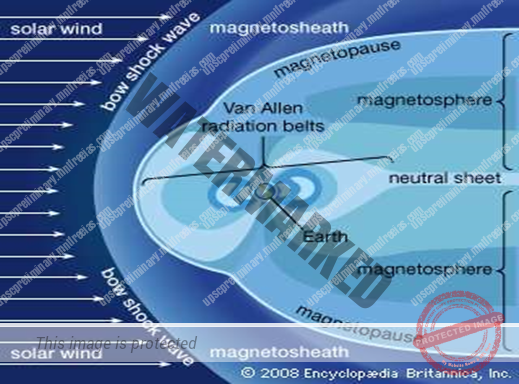- D REGION
- MAGNETOSPHERE
- EXOSPHERE
UNIT 4 – CLIMATOLOGY – PART 6
The D region is the lowest ionospheric region, at altitudes of about 70 to 90 km (40 to 55 miles). The D region differs from the E and F regions in that its free electrons almost totally disappear during the night, because they recombine with oxygen ions to form electrically neutral oxygen molecules.
At this time, radio waves pass through to the strongly reflecting E and F layers above. During the day some reflection can be obtained from the D region, but the strength of radio waves is reduced; this is the cause of the marked reduction in the range of radio transmissions in daytime. At its upper boundary the D region merges with the E region.
The E region is also called Kennelly-Heaviside layer, named for American electrical engineer Arthur E. Kennelly and English physicist Oliver Heaviside in 1902. It extends from an altitude of 90 km (60 miles) to about 160 km (100 miles).
Unlike that of the D region, the ionization of the E region remains at night, though it is considerably diminished. The E region was responsible for the reflections involved in Guglielmo Marconi’s original transatlantic radio communication in 1902. The ionization density is typically 105 electrons per cubic centimetre during the day, though intermittent patches of stronger ionization are sometimes observed.
The F region extends upward from an altitude of about 160 km (100 miles). This region has the greatest concentration of free electrons. Although its degree of ionization persists with little change through the night, there is a change in the ion distribution.
During the day, two layers can be distinguished: a small layer known as F1 and above it a more highly ionized dominant layer called F2. At night they merge at about the level of the F2 layer, which is also called the Appleton layer. This region reflects radio waves with frequencies up to about 35 megahertz; the exact value depends on the peak amount of the electron concentration, typically 106 electrons per cubic centimeter, though with large variations caused by the sunspot cycle.
It is located between 80 and 400 km above the mesopause. It contains electrically charged particles known as ions, and hence, it is known as ionosphere. Radio waves transmitted from the earth are reflected back to the earth by this layer. Temperature here starts increasing with height.
The overall structure of the outer ionosphere—the magnetosphere—is strongly influenced by the configuration of Earth’s magnetic field. Close to the planet’s surface, the magnetic field has a structure similar to that of an ideal dipole.
Field lines are oriented more or less vertically at high latitudes, sweep back over the Equator, where they are essentially horizontal, and connect to Earth in a symmetrical pattern at high latitudes. The field departs from this ideal dipolar configuration, however, at high altitudes. There the terrestrial field, Earth’s magnetic field, is distorted to a significant extent by the solar wind, with its embedded solar magnetic field. Ultimately the terrestrial field is dominated by the interplanetary field, which is generated by the Sun.
EXOSPHERE
Exosphere, outermost region of a planet’s atmosphere, where molecular densities are low and the probability of collisions between molecules is very small. The base of the exosphere is called the critical level of escape because, in the absence of collisions, lighter, faster-moving atoms such as hydrogen and helium may attain velocities that allow them to escape the planet’s gravitational field. Most molecules, however, have velocities considerably lower than the escape velocity, so their rate of escape to outer space is quite low.
The Earth’s exosphere begins about 500 km (300 miles) above the terrestrial surface and extends out through the magnetosphere and beyond to the interplanetary medium. Temperatures in the Earth’s exosphere remain constant with altitude, averaging about 1500 K. The Earth’s exosphere contains the hydrogen geocorona and the Van Allen radiation belts.

